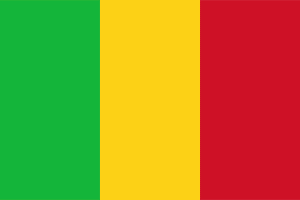
| Colors | HEX Code | RGB | CMYK |
|---|---|---|---|
| Green | #14B53A | 20, 181, 58 | 89, 0, 68, 29 |
| Gold | #FCD116 | 252, 209, 22 | 0, 17, 91, 1 |
| Red | #CE1126 | 206, 17, 38 | 0, 92, 82, 19 |
The Flag of Mali is a tricolor with equal vertical stripes colored green, gold, and red from left to right. Green is at the hoist, gold is in the middle, and red is on the fly side.
Meaning of the Flag of Mali
The green color in the flag of Mali represents the fertility of the land. The gold color stands for purity and mineral wealth. The red color symbolizes the blood shed for independence during the anti-colonial period. The colors are inspired by the Pan-African movement that resisted colonization in the 1950s.
History of the Mali Flag
Mali became a French colony in 1880. The tricolor of France was raised in the country which became part of French West Africa. After WWII, anti-colonization movements were spreading across Africa, and the Pan-African colors were used in different African flags, especially those in Ghana, Ethiopia, and Guinea. In 1959, Mali joined a confederation with Senegal, and they adopted the vertical tricolor with the sketch of a man raising his hands toward the sky. The Pan-African colors were used to show solidarity with other African countries. In 1960, Mali left the confederation, but the flag remained the same. The Islamic population objected to the Kanaga, the traditional stick man figure in the culture of Mali which was in the middle of the flag, and the Government of Mali eventually dropped the figure. The simple tricolor became official in 1961, representing Mali’s culture, history, and heritage.